Week three of Ragtime’s fitness plan started with some drama and was truncated by weather and a minor illness (mine, not his), so this was the first ride of Week Four, without having enough Week Three rides to progress to the next duration goal. But it was too lovely a day to worry about that, once I was on him and out the gate. First we went back and forth in the Near Meadow so R- could take some profile pictures of us. I want a series over time to track whether my posture and Rag’s gaits are improving, worsening, or staying (argh!) the same. Over the years without riding, and without instruction when I was riding, and with injuries from other things…my riding posture went from pretty good to awful. The thirty years of a serious writing schedule didn’t help, either…leads to snacking at the computer, weight gain, slouching over the keyboard and so on.
Why, in my late 70s, do I care whether I ride well or not? A) For the horse’s sake. Riding well helps a horse carry a rider with less strain. Leads to happier horse (usually) and fewer riding-related injuries of the horse…and the rider. Horses get better or worse with every ride: physically, mentally, and in their training. The better the rider, the more they improve every horse. Not a bad goal, to be able to give the horse an experience it can enjoy and benefit from. I’ve seen it happen when a better rider got on a horse a lesser rider had trouble with, and the horse responded. B) For my own sake. The better my riding skills, the safer I am on a horse, and the more likely I am to recognize a horse I should not ride. Working on riding skills with instruction can mitigate both lack of confidence and overconfidence. The better my riding skills, the more fun it is…if all I could do was sit on a horse being led around (as in therapeutic riding) I would not have as much fun as I do now, riding out in an open space, or would have if I could still ride over fences, ride fast, ride horses capable of doing more advanced movements. (Such as canter half pass with flying changes to zigzag down an arena…that is seriously fun! Or tempi flying changes on straight lines. Or opening/shutting gates from horseback smoothly, riding over bridges, sideways over poles, etc.) C) Riding well allows access to better horses. Money matters, but so does a rider’s skill, when they go to buy a better horse, or lease one, or take lessons on school horses. The seller or instructor may not agree to let them ride the better (or best) available horse if it’s clear they won’t be able to ride it well and may ruin it.
What physical skills does riding take? Strength, endurance, balance, quick reflexes, flexibility, the independence of arms, legs, hands (so you can balance without using the reins or saddle for balance, when the horse is moving, speeding up, stopping, turning, jumping.) Because the horse is in motion, the rider has to be able to stay in balance with the horse’s motion at all gaits (walk, trot, canter, gallop) and maneuvers (going forward, backward, sideways, turning, jumping, etc.) But let’s look at some pictures from today to illustrate. We’re still not doing anything but walk…but there are good, bad, and mediocre walks by the horse, influenced by rider balance or imbalance, flexibility or lack of it in the back and hips, strength in the core, and endurance to maintain a good position throughout a ride…or not. I still need to lose more of the fat that interferes with my riding and regain the muscle mass that used to sustain hours in the saddle riding energetic and often challenging horses.
Two years ago, I had very little core strength, weighed at least 50 pounds more, and the amount of extra weight in the front of my body contributed to the slumping upper back, and useless padding between me and the horse.
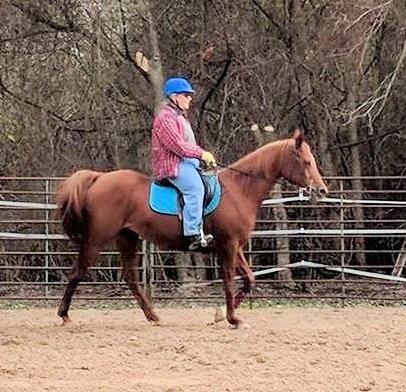

Me on Kallie, 2019, during a lesson My instructor on Kallie, 2019, date of purchase
I was, by then, able to sit erect, in the middle of the saddle, but the muscle mass was insufficient for doing anything but riding walk patterns with this excellent mare. I “filled the saddle” as you can see–from pommel to a little overlap at the cantle (not as visible) and none of that was muscle I could use to sustain balance.
Here’s a depressing picture of me on Rags, in 2021, having to lean back to maintain balance in a turn. Still overflowing the saddle. Those riding tights are the same brand I’m wearing in recent pictures, but 2X instead of large, with a waist around 42 (IIRC). There are fitter, younger people who could ride pretty well at the weight I was there, but I wasn’t fit or younger or possessed of enough muscle mass to balance without moving my body more than is easy for the horse. (Why am I looking down and to the side–to keep an eye on a jump block I’d put down as a marker to ride a small circle around.) Rags looks small for me; he’s really not.
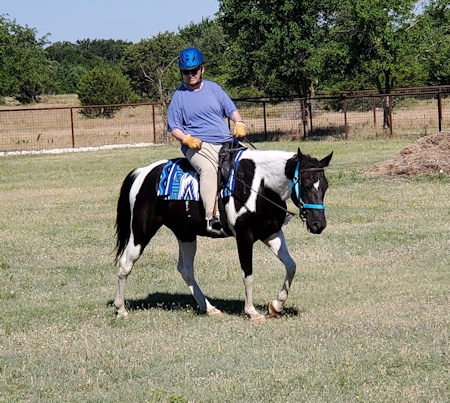
What’s different now? Some weight gone, some muscle mass restored (not yet enough of it), some improvement in cardiac & respiratory function (likewise not enough yet.) OTOH I’ve regained some weight in the past couple of weeks, so back to the protein and away with the chocolate fudge caramel pecan pie, the pancakes, and the rolls…also the Christmas candy I got as gifts.
Side Issue: The unbearable temptation of a good chocolate fudge caramel pecan pie….that’s dead easy to make. I’ve eaten a portion of four such pies this holiday season. Including at least half of each “extra” little pie that used up the rest of the brownie batch that didn’t fit in the 10 inch pie plate with the pecans and the caramel. None of those were listed in my food diary. Excuse being that I didn’t know the calorie content. Uh-huh. No more pies will be made for some months.

Back to the horse thing. Here we were today, walking back and forth while R- took pictures. I was wearing a mask to protect the place on my nose that had the skin cancer.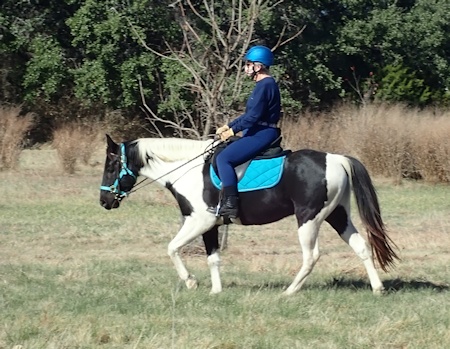
The Rider: sitting up straighter, shoulders above hips, not overflowing the saddle, heels down appropriately, hands in good position except wrists rotated so palms almost down, looking forward, appears balanced. Should have shoulder blades flattened back, neck “taller” and head retracted some, and lower leg is too far forward and upper thigh and lower torso appear a bit heavy. Rider could use more core strength. Horse: Horse and rider appear in balance, horse appears willing, moving forward well without resistance, head near-vertical and poll a little higher than withers, mouth closed. Horse’s left hind hoof is ahead of SI joint, indicating reaching under fairly well.
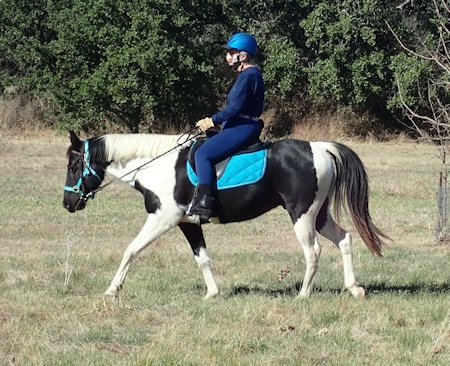
Rider: Sitting fairly straight, but still needs tighter core, head and neck up, not jutting forward from C-7, lower leg too far forward. Hands better in that palms are facing inward, thumbs on top. Rider appears relaxed and balanced, and flexing at waist with horse’s movement. Horse: head slightly lower than withers, still near vertical, reaching out well with foreleg, taking long steps for such a small horse. This horse’s conformation includes a neck coming straight out the front, making head carriage naturally low, but to get it carrying equal weight on forelegs and hind legs, it does need to develop the strength to lift its head while carrying a rider. Over time, a “low-necked” horse can learn to do that, but its rider/trainer needs to be tactful until the horse has developed the right muscles.
In following image, Rider has attempted to bring horse a little more ‘on contact’ and slightly lift the head, but has allowed hands to roll over and “flatten” again. Also appears to have shifted balance forward just a little, increasing leg pressure, and horse has taken a bigger step with hind leg. Rider would be more effective by tightening core, moving lower leg back so heel be in line with pelvis and can cue horse behind the girth on both sides, and maintaining wrist flexibility by correct hand position. Oh, and get that head up so it’s also in line with shoulders, pelvis and heel.

The problem with flattened hands (quite appropriate for some maneuvers) is that it reduces both wrist and elbow flexibility, and thus makes it harder to “follow the horse’s mouth” when its head is moving as it walks along. In the case above the rider wanted to change the horse’s head position a little–and froze the elbows and wrists, not following the mouth…and the horse initially raised its head a little but then….as below…indicated resistance to the rider’s plan, probably because the rider did not ease up the pressure when the horse’s head came up.

Now the head is just passing to “behind” vertical, but the horse is pulling, ducking its head and thus flexing *behind* the poll and gaping its mouth. The highest point on the neck is several inches behind the ears…about where the mane turns white and the poll is distinctly lower than the withers.The longer step behind no longer looks smooth and powerful, but somewhat awkward. Rider needs to release some rein and push the horse up from behind, which will take moving the lower leg back where it should be. This horse’s conformation includes being hock-wide (bow-legged) behind, which will make the transition to self-carriage (front and back legs carrying equal weight) somewhat harder, but the better the rider’s position (and stability) the easier it will be for the horse.
Here’s a picture of the horse going the other way:
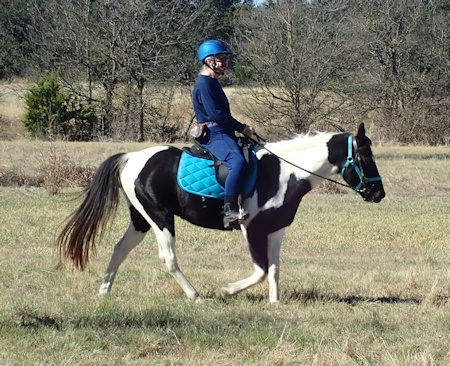
Rider: Sitting behind the movement–shoulders well behind hips. This is not necessary at a walk on horse that’s moving so freely forward, but probably related to rider’s early experiences riding western. At least rider is “sitting tall” and looking ahead, not hindering the horse much (as obvious from the large step the hind leg has taken. It appears to have tracked right up to the print of the foreleg that has just left the ground. Rider is allowing the horse plenty of rein, and the horse–though with poll slightly above the withers–has its face in front of the vertical. Horse looks energetic and is producing a good quality walk with big steps for its size. For a western-type horse, this head position is fine on the trail, esp. at this level of training. It will still benefit from learning to flex at the poll, tuck up its abdomen, and thus lift its back, reducing strain on its “lower back” (loin area) and equalizing the weight bearing of front and back legs. This particular horse is not built to handle real collection, and will be ridden with its vulnerable hocks in mind: no hard stops from speed, no fast turns, and careful introduction to canter when sufficiently muscled up.
Subsequent to the “photo session” we went across the ditch (where the nearest line of trees is) and up the east side of the dry woods, out onto the burn scar, and made a big loop there before coming back on the same trail. Rags attempted several times to stop and graze on the taller grasses, but I kept him moving without much difficulty and he went willingly onto the burn scar and down into a part of the open east end where he hadn’t been before. I thought about taking him back another way, but decided he didn’t need the extra time and might not want to go through the narrow section (tall grass on either side of a narrow mowed trail, when he didn’t know that trail at all. It was a warm sunny day, very nice for a ride outside. Since Rags was so calm about it, I was able to look over the north fence at the field there and see more of it than I can see while walking the fence. He’s got a much better walk than many larger horses I’ve ridden.

I remember from my ice dance days how ghastly one always thought one looked in photos and videos. Well, I did look ghastly, which is why we didn’t progress very far, but we had great fun trying. Anyway, the improvement over two years ago is massive!
I shouldn’t worry too much about the pies – there is a school of thought that says it’s fine to relax a bit at the weekends (and, I imagine, at Christmas) as long as you are in control during the week. That way you don’t feel deprived!
The more you learn, the more you notice what you’re not doing well yet. And yes, the pictures make it so obvious. I developed scoliosis in my late teens, resulting in part at least from a bout of encephalitis at age 5, resulting in weakness on my left side…once I wasn’t as active, and spent more time studying, the muscle imbalance got worse. Some physical therapy for a few years cleared that up, pretty much, but then (as one does) I quit doing the exercises every day, and after military service went back to college, including a lot of studying and writing.
Incredible – the sheer technical aspects of riding. Of course, if you ride long enough all of it becomes instinctual. It is good to see that you are enjoying riding Rags. I am curious – would things be better with a western saddle?
But enjoy. Stay safe and sane.
Jonathan up here in freezing New Hampshire
A western saddle imposes a different position, but I very much prefer the English saddle now, which is kinda weird for a native-born Texan. I don’t like the “saddle-seat” saddle; to me (no offense intended to those who like it and ride it well) it’s a bad cross between western and bareback. I like the all-purpose that suits most of the things I want to do very well: you can ride gallops in it, jump in it, do lower-level dressage in it, ride out on most terrain in it. It’s not that good for working cattle, serious mountain riding where you need to carry some gear on your horse (tools, slicker, one or two days’ food), and I hope to acquire a trail saddle or western saddle (western has the “horn”; the trail saddle has an arch) lighter than the western one I have now. I don’t see myself dragging a bovine around, or helping get a vehicle out of mud, so not needing the full western rig again. I do think I’d like to take longer rides with others, for which (in this part of the country) an English saddle would not be idea.
Experience and instruction do eventually (!!) make a lot of the finer aspects instinctual, but any long gap w/o riding erodes the “feel” and the rider tends to revert to what the body would prefer…feels fine, but isn’t. The 2018 concussion killed my feel completely (the first six months of riding after that did not feel like really riding. Then one day I got on, the horse walked off and BOOM, the feeling was back. Luckily. But not all the feel…and I have no one in the family who knows, or wants to learn, how to coach my position. Thus pictures are necessary but not really sufficient. Good instruction tells you right away…”Shoulders DOWN…stretch your neck UP…BOTH heels down…your right hand bobs up and down too much…elbows!…horse isn’t pulling, YOU are…heels under your hips! No, another inch back. There. More inside leg on the turns on this rein…more still…”
Videos help a lot, but you have to find someone willing to stand there and film all the boring bits, and ideally the person is able to offer some good critique. (Boring to non-riders…riders are rarely bored by the bits that matter to them and whatever riding discipline they’re in. Non-riders, or riders in a different discipline can be easily bored by something they don’t bother with.) Anyway…people serious about riding, like people serious about singing, or golf, or any other activity, often go on taking lessons/coaching long after they’re better than 95% of others in that activity. That’s why they’re that much better. If I had a good instructor nearby, and could afford it (lack of good instructor nearby, but the good ones do cost) I would’ve been taking lessons all through my non-riding periods.